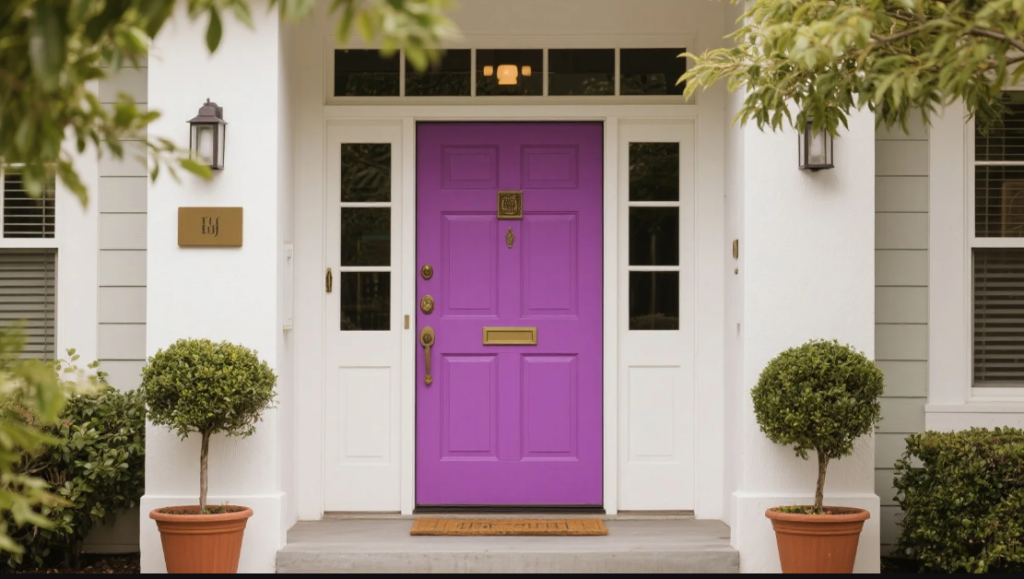Your front door is more than just an entry point. In Feng Shui, it’s called the “Mouth of Chi,” where energy enters your home. Choosing the best color for front door feng shui can dramatically affect your wealth, health, and overall fortune. But how do you know which color truly fits your home and energy goals?

Why Front Door Color Matters in Feng Shui
First impressions count—not only for guests but for energy flow too. The front door sets the tone for the entire house. Colors act like magnets, attracting specific types of energy.
For example, red front doors are known to attract fame and recognition. Black doors symbolize water energy, often linked to career growth and opportunity.
Take Sarah and Mike as an example. They painted their front door green, aligning with the wood element, and soon experienced improved family harmony and financial stability.
However, it’s worth noting that choosing the wrong color may unintentionally block opportunities or invite unwanted energy.
Choosing the Right Color Based on House Direction
A proven way to select the best color for front door feng shui is by considering your home’s compass direction. Each direction aligns with a specific element and color category.
For north-facing doors, black or dark blue represents the water element, enhancing career prospects.
South-facing doors benefit from red, orange, or purple, all connected to the fire element. These colors promote fame and passion.
East and southeast doors harmonize with green and brown, linked to the wood element. This choice boosts family growth and financial luck.
For west and northwest doors, white, gray, or metallic tones support helpful people and travel luck.
Interestingly, northeast and southwest doors thrive with earthy tones like beige, tan, or light yellow. These stabilize relationships and health.
Let’s look at John’s case in Chicago. His house faced south, but his door was dark blue. After repainting it bright red, he received unexpected job offers within a month.
The Emotional Impact of Front Door Colors
Beyond compass direction, colors also trigger emotional responses.
Red brings excitement and energy. It draws attention and makes a bold statement.
Green signifies growth, balance, and renewal. It’s ideal for families wanting emotional healing or stronger bonds.
Blue promotes peace and calmness. However, overuse may dampen social energy.
White reflects purity and clarity, great for those wanting a fresh start.
Black symbolizes strength and mystery. Though powerful, it should be used mindfully.
However, it’s important to avoid dull, chipped, or faded colors. A neglected door can block positive chi, no matter the color.
Emma from New York once had a faded gray door. After repainting it pure white, she noticed improved clarity and better communication with neighbors.
Common Mistakes When Choosing Front Door Colors
One of the most frequent mistakes is choosing a color just because it’s trendy. What works for one house may harm another based on location and energy alignment.
Another mistake is ignoring the surrounding elements. For example, placing a bright red door on a metal-dominant west-facing house may create elemental conflict.
Also, people sometimes forget to clean or maintain their door after repainting. Dirt and peeling paint can cancel out even the best Feng Shui intentions.
Interestingly, many homeowners believe that black doors are universally good for career luck. However, using black on a south-facing home (fire sector) can suppress energy flow, leading to stagnation.
A real-life example: Mark from Seattle painted his south-facing door black. Within months, he felt unmotivated at work. After switching to deep burgundy, his energy bounced back.
Enhancing Front Door Energy Beyond Color
While the best color for front door feng shui plays a big role, color alone isn’t everything. Additional elements can strengthen the energy even more.
Adding plants near the entrance brings wood energy and promotes growth.
Placing a welcome mat with auspicious symbols helps invite positive chi.
Good lighting ensures the door is well-highlighted, making energy flow smoother.
For metal element homes, consider metal door knockers or address numbers in silver tones.
However, worth mentioning is the fact that clutter around the entrance, even with the right color, will reduce energy flow.
Samantha from Texas cleared her front porch and added two potted plants after painting her door dark green. Soon after, she noticed improved family communication and fewer financial hiccups.
Real-Life Color Transformation Stories
Sometimes, even small changes bring surprising results.
Laura had a pale beige door on her north-facing house. After consulting a Feng Shui expert, she switched to navy blue. Within two months, her long-delayed business project took off.
Ben from Florida painted his west-facing door white and hung a metal wind chime nearby. He soon received travel opportunities he’d been hoping for.
Then there’s Olivia from Toronto, whose house faced southeast. After moving from dull brown to fresh green, her family relationships improved remarkably.
These stories show how the best color for front door feng shui can influence different life areas, from career to family harmony.
Step-by-Step Guide to Picking Your Perfect Front Door Color
If you’re still unsure, follow these simple steps:
- Determine your home’s compass direction.
- Understand which Feng Shui element governs that direction.
- Choose a color that matches both the element and your personal goals.
- Consider your neighborhood aesthetic while staying true to Feng Shui.
- Before painting, test color swatches in different lighting.
Finally, after painting, keep your front door clean and well-maintained. Even the perfect color won’t help if the door appears neglected.
Final Thoughts: Let Your Front Door Welcome Good Fortune
Selecting the best color for front door feng shui isn’t about following trends. It’s about aligning your home with nature’s elements and setting the stage for good things to flow in.
Whether you seek wealth, health, love, or peace, the right front door color can serve as a powerful first step.
